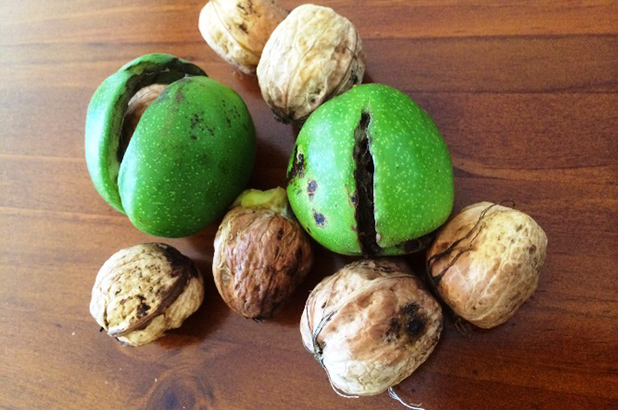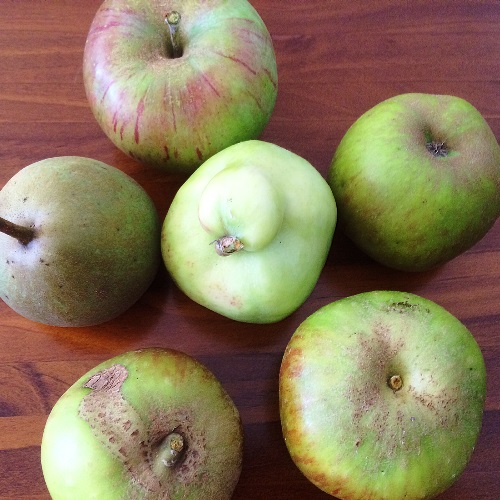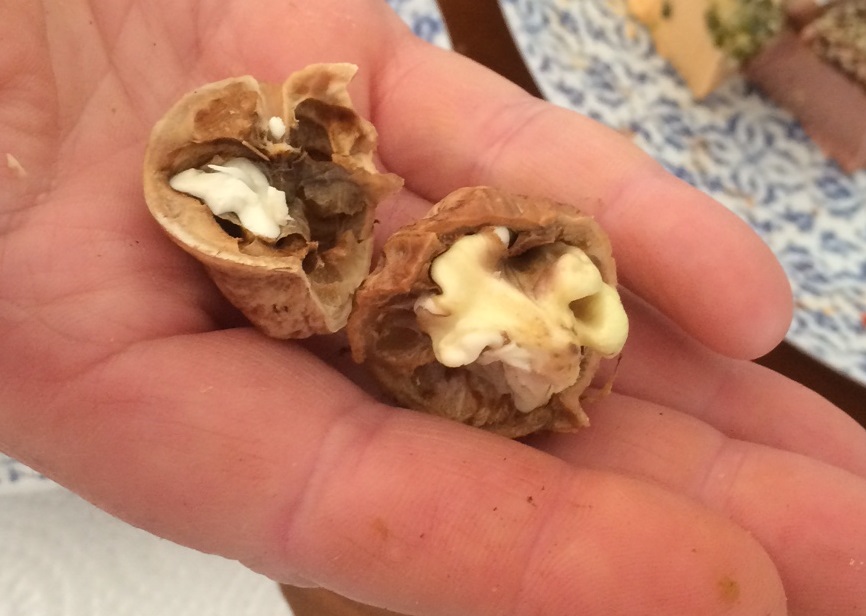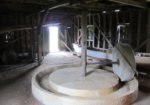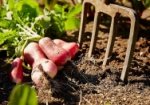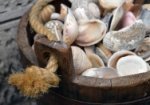I had the decidedly good fortune to be in Tasmania last week, taking in some of the convict and heritage areas around Hobart. With so many Georgian buildings, Hobart itself offers a glimpse of what the Sydney Cove settlement would have looked and felt like in its very early days. Early autumn is a perfect time to visit, and following from the Curator’s focus on Rouse Hill’s autumnal produce last week, I delighted in finding heirloom beans and tomatoes (which I’m snacking on as I write) in abundance, and apple, pear and walnut trees heavy with fruit.
A convict trail
My principal destination was the Tasman Peninsular, for its World Heritage listed convict sites at Port Arthur and the Saltwater River coal mining settlement. These places present very different stories to Sydney’s convict and colonial heritage, although there are direct parallels and associations with Hyde Park barracks, also World Heritage listed. Each is convict built, and like Hyde Park barracks, its masonry is held together with lime made from seashells harvested locally. Although rarely mentioned as part of the convict foodways, oysters would have played a significant role in the diet.
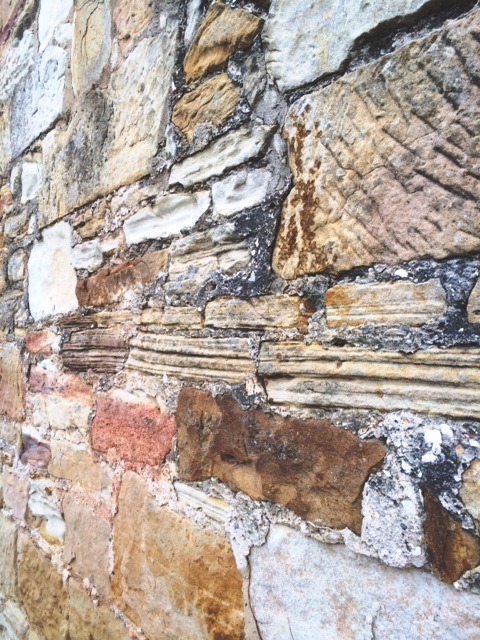
Convict built stone wall with shell-lime mortar, Saltwater River, Tasmania. Photo Jacqui Newling © Sydney Living Museums
In the footsteps of Lady Jane
The intrepid Lady Jane Franklin (wife of the governor of Van Dieman’s Land, John) wrote of her visit to the region in 1837, passing through Eaglehawk Neck, noting that even the guard dogs were on rations – a pound (450g) of biscuit per day mixed with a few ounces of fat and appraising the convicts’ bread and soup. She stayed overnight at the Commandant’s house at Port Arthur, which is one of the most intact buildings in the Port Arthur historic site and has a wonderful focus on food in its current museum interpretation. Its ‘back-of-house’ comprises various kitchen and food storage rooms, used in different ways over time, according to residents’ needs (the premises operated as a hotel for some considerable time in the early 1900s). I was intrigued to compare what now stands with Lady Jane Franklin’s brief account of the house, when she stayed there in March 1837:
The house is [a] building of one storey with verandah round closed by green Venetians, so that [the] house is entirely shrouded and blinded by them. … sitting room and 2 bedrooms, kitchen and office detached at back … comfortable sitting room full of things …
Fine dining, Port Arthur style, 1837
Lady Franklin described their meal, which included locally caught fish and kangaroo, served to her at dinner:
Excellent dinner, kangaroo soup ? but steamer excellent. Is made of layer of pork then this bits of kangaroo, sprinkled with fine pot herbs, or what is better with nutmeg and so on, made into a small round, like a fillet of veal, no water, but steamed by its own gravy – was very good. had trumpeter fish, excellent.
We have profiled the kangaroo steamer in previous posts, and you can see yours truly making the steamer, and kangaroo tail soup, on TVS or YouTube if you are curious. Trumpeter is indeed, a very fine fish, and often served in local pubs and restaurants. When I asked about the fish on the menu at a local pub in Hobart, this was proprietor Pip Cardno’s answer (excuse the phone pic quality):
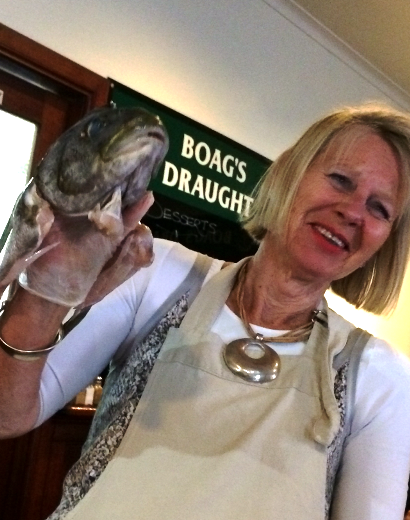
Pip Cardno, with fresh local trumpeter on the menu at the Crescent Hotel, Hobart. Photo Jacqui Newling © Sydney Living Museums
Heirloom gardens
In its hey-day as a penal settlement the convicts tended a substantial food garden to augment their rations of bread and salted meat broths, generally potatoes, cabbages, turnips and the like. Individual households, including the commandant’s, supplied their kitchens with homegrown produce, probably of a more select nature than the hardy types issued to the masses. The Commandant’s cottage boasts a small kitchen and herb garden today, planted with heirloom vegetables and well fenced to keep native nibblers out.
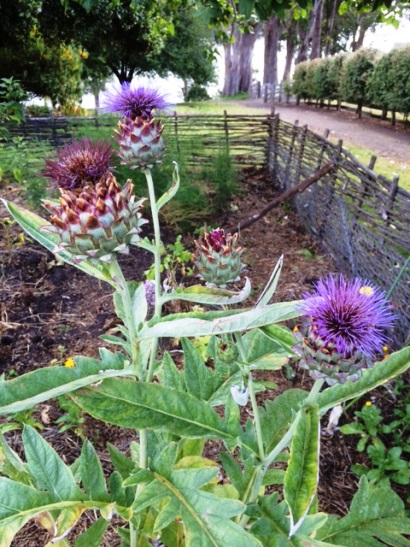
Artichokes in the kitchen garden, Commandant’s cottage, Port Arthur. Photo Jacqui Newling © Sydney Living Museums
Eve’s orchard
Another garden on the site, at the Policeman’s house (see map below), reflects later use of the site, in the 1920s, when the area was named Carnarvon, in an effort to block out the cruelty and hardship of its past infamy. Behind the house is a small apples orchard, boasting 22 heirloom varieties, with a welcoming sign saying ‘when in season, help yourself’! Many of the trees were bearing fruit, of varying shapes, colours and sizes, offering a fascinating opportunity for sampling. It was fascinating to note the changes in taste and texture; some were tart, some dry and floury, and just as we’d decided perhaps we are luckier with our modern choice now than our forebears, we tasted a deliciously sweet, crisp specimen (front right below). These were a little blemished on the skin but as we know, looks can be deceiving, and means they wont be found in a supermarket!
The green Granny Smith style was extraordinarily sour, taking my companion aback but very satisfying for me. Now relatively sweet, modern Granny Smiths render it almost impossible to imagine apples being added to curries as a souring agent, but these ones make it all make sense. When the English tried to replicate curries they ate in India, that were made with cinnamon leaves, sour tamarind and under-ripe green mango, they had to substitute with English alternatives: bay leaves, raisins and sour apples. Over time of course, the attempt at authenticity faded and for many generations, we were left with a cloyingly fruity curry, made with sweet sultanas and eating apples.
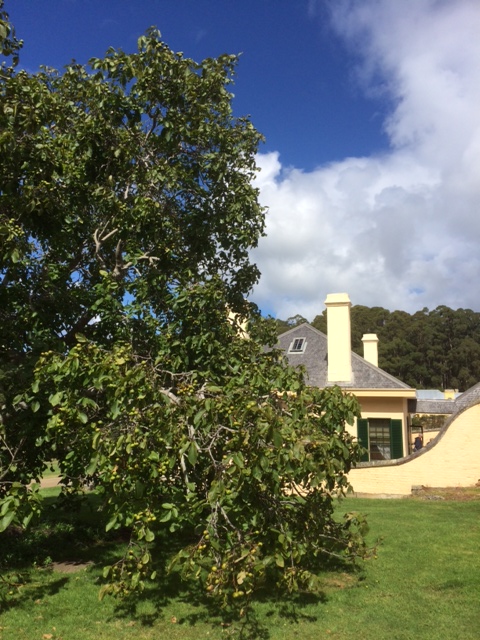
Walnut tree and Junior Medical Officer’s house, Port Arthur, Tasmania. Photo Jacqui Newling © Sydney Living Museums
Ripe for the picking!
Another very large tree that caught my eye with majestic stature, was laden with burnished green-brown pears, but too far up for me to reach. In the grounds of the Junior Medical Officer’s house (see map below) was another tall tree, studded with small, bright green, waxy skinned fruit, many of them starting to split open. Although well within my reach, it wasn’t until I looked in the grass beneath the tree that I realised this was a walnut tree, a very old one, I imagine. Needless to say I gathered as many as my pockets would hold (my bag was already full of apples!) and sampled them that evening.
Blind faith
This was my first experience of fresh walnuts and I had never thought about how they should be prepared for consumption (Mr Google couldn’t help as there was no 3G where I was staying in Port Arthur). The ones still in their fleshy skins were slippery and hard to manage (you can see the pale green inner-flesh still sticking to the middle nut in the picture at the top of this page), the better exposed ones much easier to open. The nut inside was mild and milky, almost like a blanched almond in texture, with just a hint of characteristic walnut earthiness, and the bitter edge that many walnuts develop was undetectable. The membrane which usually attaches itself to the nut was difficult to separate from the shell and we realised that they were actually too fresh. As we figured from our experimenting, walnuts need to be dried for a time, partly to ensure they can be stored without becoming mouldy, but also for the nut to develop in the way we are familiar with them. Be that as it may, it was worth the experiment and added to the enjoyment of my trip along the convict heritage trail.
And the apples, if you are wondering? The sweet ones we ate with a soft Tasmanian brie, and the floury-soury ones stewed up beautifully, with just a small amount of sugar for their syrup.
